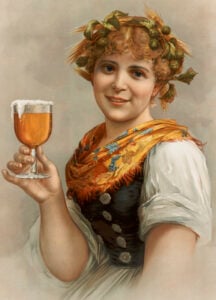When I first started working at a brewery and learning about beer, I heard someone telling a story about Ninkasi, the goddess of beer in ancient Sumerian religious mythology.[1] As a historian I knew how important beer was in early America. Many water sources were often polluted and unsafe for drinking, so low-alcohol beers and ciders were brewed for everyday drinking. “Americans drank an average of thirty-four gallons of beer and cider, five gallons of distilled spirits, and one gallon of wine per year in 1790.”[2] I had not given much thought to the beginnings of beer, or to brewers and the ingredients they used. This story about the goddess of brewing sparked my interest to learn more about brewing and beer history.
Beer is nothing new. It has been being brewed in some form or another since ancient times. In archaeological digs in Sumeria (a region in southern Mesopotamia), a clay tablet dating to 6000 BC was found with a recipe for “beer”; this is considered the oldest such recipe. This Sumerian beer is very different from what we might consider to be beer today. Some historic beers today would be more akin to spiced wines or other malted beverages. Women were allowed to brew the beer and run taverns according to the Code of Hammurabi (a set of laws in Mesopotamia). Historians believe the use of the word “she” to describe every tavern owner gave only women the right to operate taverns during this time.[3]
In ancient Egypt, Hathor was the Inventor of brewing and goddess of intoxication. Sculptures, paintings, and other forms of art show mostly women brewing.[4] Since brewing literally meant that the beer was boiled prior to being fermented, this “chore” fell into the household, which women oversaw. Even later, in early America, Thomas Jefferson was known as a “brewer,” even though his wife Martha was mostly responsible for the daily operation of overseeing the brewing process.
Elite women in the Incan Empire were responsible for brewing beer for use in festivals and feasts, for religious practices, and even as a form of currency.
Elite women in the Incan Empire were responsible for brewing beer for use in festivals and feasts, for religious practices, and even as a form of currency. A corn beer was prominent in South America as corn was plentiful; this was seen in early American brewing as well, with other grains unavailable or hard to get.
In the Medieval and Renaissance era in England, according to Judith M. Bennett (author of Ale, Beer, and Brewsters in England), women were once responsible for most of the beer produced and drank. Brewing beer and operating taverns were two of the few jobs a women could do outside or adjacent to the home. In some instances, records show that husbands who operated breweries left their equipment and businesses to their wives when they died, thus creating a way for widows to provide for themselves.
As beer became more and more popular, women began to fade from its production. Historians disagree on the reasons women left the brewing industry: some believe that as beer became popular and profitable men pushed women out, others think that women themselves left the brewing industry for others. Either way, the decline was sharp and today, according to the Brewers Association, in 2019 women represented just 7.5% of the workforce in the brewing industry.
Notes
[1] Joshua J. Mark, “The Hymn to Ninkasi, Goddess of Beer,” World History Encyclopedia, 29 June 2021, https://www.worldhistory.org/article/222/the-hymn-to-ninkasi-goddess-of-beer/.
[2] “The Revolution of American Drinking,” U.S. History Scene, http://ushistoryscene.com/article/american-drinking/ (accessed 23 June 2021).
[3] Kristen Richard, “A Brief History of Women and Beer, From Sumerian Goddesses to the Pink Boots Society.” Wine Enthusiast, 29 January 2021, www.winemag.com/2020/12/22/women-beer-history/ (accessed 23 June 2021).
[4] Ian S. Hornsey, A History of Beer and Brewing (Cambridge: Royal Society of Chemistry, 2003).
Share this:

About Rebecca Carpenter
Rebecca Carpenter earned her BA in History from Fitchburg State University and her MA in History from the University of Massachusetts Boston. Before joining NEHGS, she worked for the Museum of Fine Arts, Boston, and the Dedham Historical Society & Library, where she found a love for genealogical research. In her off time she enjoys trying out new breweries, reading history books, and exploring.View all posts by Rebecca Carpenter →
